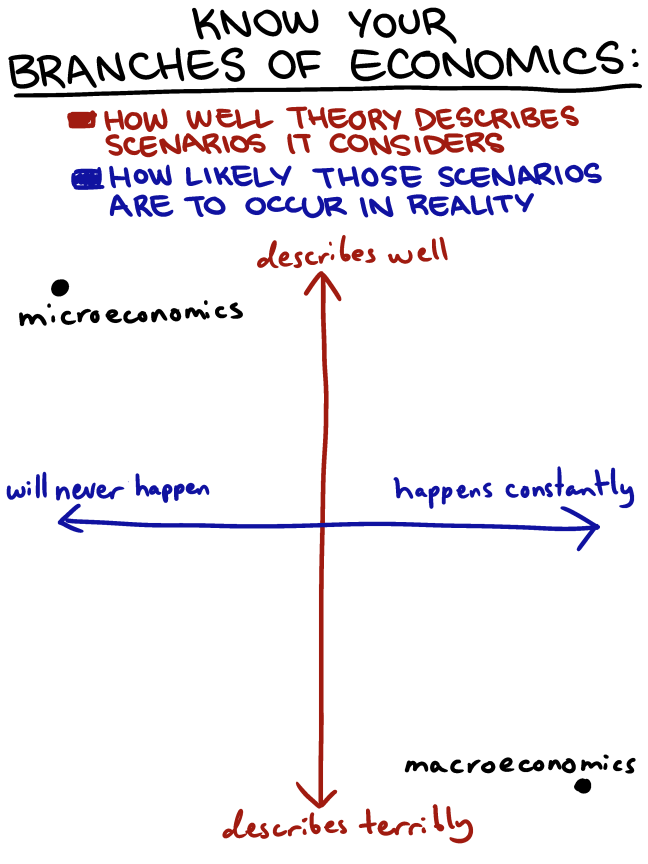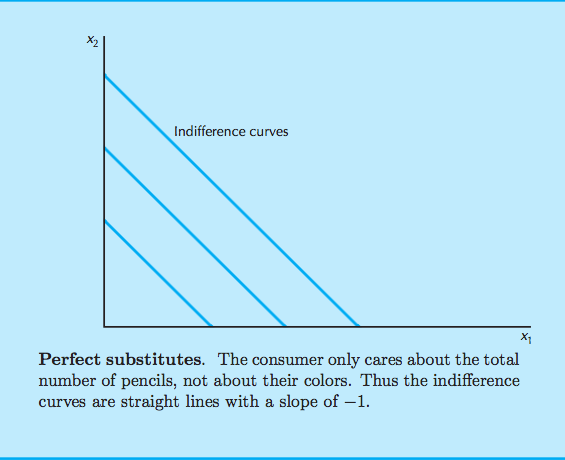An introduction to Microeconomics
by Jesús García
What is Economics?
What it's not
- Business/Management
- Accounting
- Finance
Economics is a science which studies human behaviour as a relationship between ends and scarce means which have alternative uses.
Micro
Actions of individuals and firms
Macro
Activity in a country, market, the world

Models
Every model is wrong, but some are useful
Supply and Demand
Experiment time!

Market equilibrium
Conditions:
- Equal access to information
- No externalities
- No monopolies (perfect competition)
Elasticity
Consumer theory
p1x1 + p2x2 = m
The budget constraint

Indifference Curves

Perfect substitutes
The consumer is willing to substitute one good for the other at a constant rate.

Perfect complements
Goods that are always consumed together in fixed proportions.

Marginal rate of substitution
The slope of an indifference curve is known as the marginal rate of substitution (MRS). The name comes from the fact that the MRS measures the rate at which the consumer is just willing to substitute one good for the other.

Game Theory
The study of mathematical models of conflict and cooperation between intelligent rational decision-makers
• The set of players is N = {1,...,n}.
• Player i has a set of actions, ai, available. These are generally referred to as pure
strategies. This set might be finite or infinite.
• Let a = a1 × ··· × an be the set of all profiles of pure strategies or actions, with a generic element denoted by a = (a1, . . . , an).
• Player i’s payoff as a function of the vector of actions taken is described by a function ui : A → IR, where ui(a) is i’s payoff if the a is the profile of actions chosen in the society.

Text
Text
Prisoner's dilemma
Dominant strategies
A dominant strategy for a player is one that produces the highest payoff of any strategy available for every possible action by the other players.
That is, a strategy ai ∈ ai is a dominant (or weakly dominant) strategy for player i if ui(ai, a−i) ≥ ui(a′i, a−i) for all a′i and all a−i ∈ a−i.
A strategy is a strictly dominant strategy if the above inequality holds strictly for all a′i ̸= ai and all a−i ∈ a−i.
Nash equilibrium
A pure strategy Nash equilibrium4 is a profile of strategies such that each player’s strategy is a best response (results in the highest available payoff) against the equilibrium strategies of the other players.
A strategy ai is a best reply, also known as a best response, of player i to a profile of strategies a−i ∈ a−i for the other players if
ui(ai, a−i) ≥ ui(a′i, a−i) for all a′i.
A best response of player i to a profile of strategies of the other players is said to be a strict best response if it is the unique best response.
A profile of strategies a ∈ A is a pure strategy Nash equilibrium if ai is a best reply to a−i for each i. That is, a is a Nash equilibrium if
ui(ai, a−i) ≥ ui(a′i, a−i) for all i and a′i.
An advertising game

Experiment time!
Competition and Industrial Economics
Competition
- Perfect competition
- Oligopoly
- Monopoly
Perfect Competition
In the long run, profits in an industry with free entry will induce other firms to enter that industry and thereby push profits toward zero.
When profits are zero it doesn’t mean that the industry disappears; it just means that it stops growing, since there is no longer an inducement to enter.
Monopoly
Monopoly
Price discrimination
1st, 2nd and 3rd degree
Under first-degree price discrimination, or perfect price discrimination, each unit of the good is sold to the individual who values it most highly, at the maximum price that this individual is willing to pay for it.
Second-degree price discrimination is also known as the case of non- linear pricing, since it means that the price per unit of output is not constant but depends on how much you buy.
Third degree p.d.: the monopolist sells to different people at dif- ferent prices, but every unit of the good sold to a given group is sold at the same price.
Examples of this might be student discounts at the movies, or senior citizens’ discounts at the drugstore.
Oligopoly
Cournot model

Behavioral Economics
Economic experiments
• Participants play games (or take decisions). Choices are recorded as data.
• Experiments can take place in a laboratory or in the “field“.
Experiments investigate real choices in contrast to surveys with attitudinal questions
They show the revealed preferences of the participants
Economic experiments
Behavioral / experimental economics argues that
a) people often make choices that do not maximize their utility.
b) psychological and physiological evidence is relevant for economic theories.
Therefore, not only choices but also expectations, brain activity, physiological processes, eye movements, etc. are measured in experiments.
Economic experiments
Should economists deal with expectations, emotions, social norms, happiness, or should they restrict themselves to revealed preferences?
Resources
Intermediate Microeconomics - Hal Varian - graphs and explanations used throughout these slides
Prospect theory - Kahneman and Tversky's seminal paper on behavioral economics
Books: